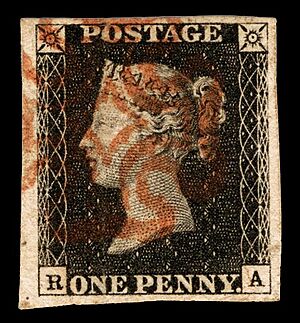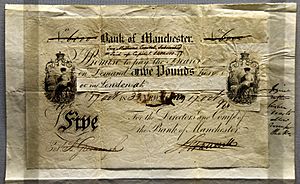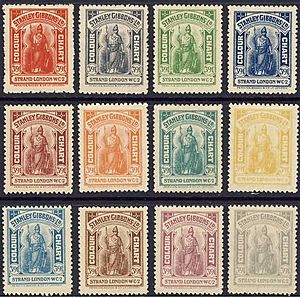Perkins Bacon facts for kids
Perkins, Bacon & Co was a famous company that printed books, money (bank notes), and postage stamps. They are most famous for printing the Penny Black in 1840, which was the world's very first postage stamp that stuck to paper!
Quick facts for kids Details on the mode of preventing the forgery of bank notes |
|
|---|---|
| Back in the early 1800s, people in England were making fake money (forging currency) very often. Even small bills were being faked by people who weren't very skilled. The government made it a crime that could lead to death, but this didn't stop the forgeries.
Around 1818, England's Royal Society started looking into this problem. They studied money from all over the world. They were very impressed by the money printed by an American inventor named Jacob Perkins for Massachusetts. The new "National Bank" in the USA even chose Perkins' special printing plates for their new national money. In England, a man named Charles Heath spoke to the Royal Society about Jacob Perkins. Perkins was amazing because he invented "soft steel" plates that could be engraved (carved) and then made hard. This made them last much longer. He also invented a special roller that pressed harder and plates that could print 64 pieces at once. He even invented other things like nails and fire equipment! A special machine called a lathe was used to make very complex designs for the money. This made it harder to copy. Charles Heath invited Jacob Perkins to England because England was offering a huge prize of £20,000 to anyone who could create money that couldn't be faked. Jacob Perkins received £5,000 and traveled to England with his machines, plates, and helpers. He was sure he would win the prize. He left his brother in charge of his business in Boston. He gave presentations and made sample money. He worked in London for months. But in the end, England decided not to give the big contract for national money to someone from another country. Even though they didn't hire him then, the reports mentioned Jacob Perkins' methods more than anyone else's. They ended up using some of his ideas. At the time, England used copper plates for their money, and they needed 1,500 new plates every year. Perkins' steel plates would cost the Bank of England much less and produce much better quality money. They realized his steel plates would last so long that the true cost would be less than one-tenth of what they were paying! |
How Perkins, Bacon & Co Started
Jacob Perkins was an inventor who created and sold special "soft steel" plates for engraving. These plates were engraved first and then made very hard. They were quite thick and heavy. Perkins printed some money in the USA. With an engraver named Gideon Fairman, he also produced the first books in the USA that were engraved on steel. These were eight-page books called Perkins and Fairman's Running Hand. They printed money for Massachusetts and won the contract to print money for the new USA National Bank. They were from Boston, Massachusetts.
Charles Heath convinced Jacob Perkins to come to England. This was because, out of all the money printed around the world, Perkins' notes were thought to be the best. Perkins arrived in London with Gideon Fairman and Asa Spencer. They set up their business as Perkins and Fairman. For several months, they worked only on trying to win the big project for the Bank of England.
After a few months, Perkins owed a small amount of money to the Heath family. So, Perkins and Fairman made Charles Heath a partner. They moved their business to 69 Fleet Street. Charles Heath sometimes owned half of the company.
Jacob Perkins, Gideon Fairman, George Heath (who only helped with money), and Charles Heath then formed a new company called "Perkins, Fairman, and Heath". They printed some books, stamps, one-pound notes for English banks, and other money. The stamps they made were the very first stamps in the world that had glue on the back to stick them! Jacob Perkins and Charles Heath also had other successful businesses at the same time.
Perkins and Charles Heath sometimes had money problems, even though they were very talented. Luckily, they kept excellent records of any money owed to the company, shares sold between them, and how much of each project they owned.
Important Dates for the Company
- 1808-1810: Jacob Perkins and Gideon Fairman create the first known books in the US using steel plates.
- Around 1816: Jacob Perkins develops "soft steel" plates for engraving, a way to harden them, and a special process.
- April 15, 1818: Charles Heath talks about the American bank notes printed by Perkins at a meeting about forgery.
- The Bank of England offers a £20,000 prize for money that cannot be faked.
- May 31, 1819: Perkins sails for England after talking with Charles Heath.
- June 29, 1819: Perkins arrives in Liverpool, England.
- July 1819: Sir Joseph Banks meets with Perkins.
- December 20, 1819: The Heaths join Perkins and Fairman, forming Perkins, Fairman and Heath.
- 1819: George Heath provides some financial support.
- February 1820: The Bank of England chooses a different solution. However, other business comes in, including £1 notes and stamps.
- February 1820: Perkins, among other projects, starts a book publishing business with the Heaths and Fairman.
- Summer 1820: Perkins Fairman and Heath move to 69 Fleet Street, London.
- September 1820: Perkins sells 1,000 plates he had planned to use for the Bank of England project.
- 1822: The company is known as Perkins and Heath.
- 1829: The company becomes Perkins and Bacon. Joshua Butters Bacon (Perkins' son-in-law) buys out the Heaths' share.
- 1834-1852: The company is called Perkins, Bacon & Petch. Henry Petch, an engraver, becomes a partner.
- 1839: Perkins Bacon and Co is asked to make plates and dies for stamps. The Penny Black is their first stamp.
There was a time when both Perkins, Bacon & Petch and Perkins, Bacon and Co existed. Not all business projects included all partners. The ownership percentages changed as shares were bought and sold, and money was loaned between partners. Also, Charles Heath and Jacob Perkins had many other individual businesses going on at the same time. Both Heath and Perkins were very talented and successful, but they often had money problems. Luckily, their accounting records were very good. Charles Heath worked with some people for many decades.

Company History
England had offered a prize of £20,000 for a bank note that was impossible to fake. Charles Heath contacted Jacob Perkins and convinced him to come to England. Perkins arrived in Liverpool in 1819. They showed samples to Sir Joseph Banks, who was in charge of the Royal Commission on Forgery. It looked like they would win the prize, but they didn't. Perkins started to have some money troubles and owed a small amount to the Heaths.
They did manage to get smaller jobs, like printing £1 notes. Later, they won more government contracts. In the meantime, they also started publishing books.
George Heath, Charles Heath, Jacob Perkins, and Gideon Fairman had many different partnerships and individual projects happening at the same time. George Heath only helped with money. Charles Heath was an engraver and a book publisher. Jacob Perkins was an inventor who made steel book plates practical. Fairman had produced a book with Perkins in the USA.
One of the partners often owed money to the company. Their accounting records are detailed but can be confusing. The percentage of profits they got from each project changed often.
By 1822, the company was known as "Perkins & Heath". Then, in 1829, after a complex deal where Heath gave up his shares and Joshua Butters Bacon (Perkins' son-in-law) bought in, it became "Perkins & Bacon". Henry Petch joined in 1835, so the company that printed the first stamps was actually called "Perkins, Bacon & Petch". The printing plates for the Penny Black stamp are now on display at the British Library. When Petch passed away in 1852, the company went back to being "Perkins, Bacon".
In 1861, they temporarily lost the contract to print stamps. This happened because they gave copies of new stamps to friends of the management without permission from the governments involved. Even though Charles Heath had won a court case that allowed engravers to keep 8 copies of any engraving, this rule did not apply to money or stamps.
They finished their contract for printing line-engraved stamps on December 31, 1879. They lost future business to a competing company called De La Rue.
Besides British stamps, Perkins, Bacon printed stamps for many of the colonies. This included the first stamps of the Cape of Good Hope, which they printed in 1853.
In 1935, the company closed down. Its records were bought by Charles and Harry Nissen and Thomas Allen. Later, these records were acquired by the Royal Philatelic Society London, where Percy de Worms organized them for publishing and display.



